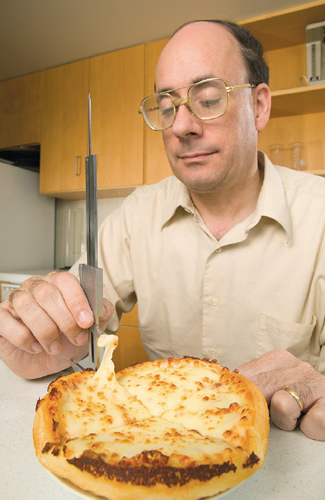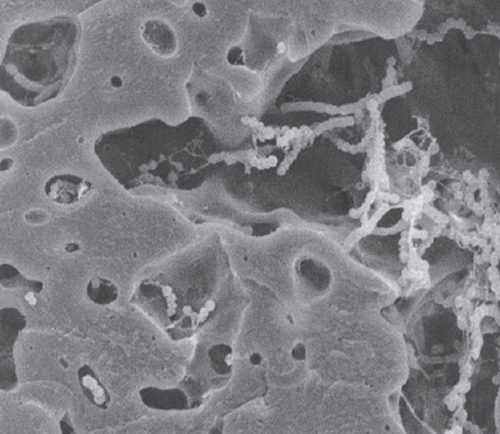
This Article From Issue
September-October 2014
Volume 102, Number 5
Page 389
DOI: 10.1511/2014.110.389
THE SCIENCE OF CHEESE. Michael H. Tunick. xx + 281 pp. Oxford University Press, 2013. $29.95.
My reading of The Science of Cheese, by Michael H. Tunick, coincided with a surge of cheese-related controversy, when the U.S. Food and Drug Administration (FDA) attempted to ban the practice of ripening cheeses on wooden boards. Many artisan cheese makers follow this traditional practice. In fact, certain kinds of cheese must be aged on a board for their labeling to legally bear the variety’s name. In the face of public outcry and protests from producers about how the ruling would harm cheese making (and cheese eating) in the United States, the FDA backed down. Perhaps the whole issue could have been avoided if the agency had consulted a cheese scientist at the outset.

From reading The Science of Cheese, it’s apparent that Tunick, a chemist at the U.S. Department of Agriculture, would have been an excellent choice. The author’s lucid explanations draw on both his research background and his firsthand experience with cheese making. That wide, deep knowledge is evident in the exceptionally specific information throughout the book, as when Tunick notes the exact molecules contributing each aspect of flavor to cheeses. For example, we learn that 1-octen-3-ol and 1-octen-3-one provide the mushroom aroma of surface mold cheeses. Many of the photographs included in The Science of Cheese are Tunick’s own.
Lest you think that the book reads like a technical manual, never fear. The abundant data are interspersed with compelling stories and cultural insights. More than two dozen cheeses get a moment in the spotlight as Tunick describes their place of origin and etymology. Along the way, the book answers a broad range of questions you may not have realized you had. For example, how did humans evolve to be lactose tolerant? Why do cheese curds squeak? Why does freezing ruin the consistency of cheese? Why are barns traditionally red? (Their ruddy hue, it turns out, had practical origins. Before the advent of commercial paints, farmers used to coat their barns with a concoction of milk, lime, and linseed oil. The milk-lime combination helped the mixture bind to the wood. Rust was added as a natural fungicide, resulting in a reddish color.)

The first three chapters of The Science of Cheese include foundational information such as cheese science terminology, the animals whose milk is used in cheese, the primary steps of the cheese-making process, and the basic science that occurs. A scanning electron microscope image of starter bacteria in a matrix of casein (milk protein) proves a useful visual, along with photos of cheese-making vats. Still, I wish these chapters had included diagrams to illustrate the science, which I had some trouble picturing and absorbing.
The next chapters cover specific types of cheese and describe the science especially important to each type. For example, chapter 6 concerns stretched-curd cheeses, such as mozzarella, and includes a discussion of alcohols in cheese: Alcohol is a surprising but important flavor contributor in stretched-curd cheeses. This chapter also explores the science behind melting and browning cheese, two aspects for which mozzarella is well known. Chapter 7 focuses on surface mold varieties, such as Camembert and Brie. Here Tunick discusses some of the characteristic chemical properties of these cheeses, such as their distinctive-smelling sulfur compounds and the use of ash in making them.
The book culminates with a group of chapters covering “process cheese” (the legal name in the United States, instead of “processed cheese,” for blended products such as American cheese) and nutrition, the chemical analysis of cheese, and the laws that regulate cheese production and labeling. All the cheeses previously described are brought together in massive tables outlining the key molecules in each and the aromas that result.
Although the book’s organization by cheese type made sense, I sometimes wondered how widely applicable the chemistry was. Did the molecules described in one chapter influence other cheeses as well? There were moments when the description veered into territory I found overly technical for the main narrative. For example, the book includes step-by-step instructions for making each cheese, such as these for mozzarella:
Milk is cooled to 90°, starter is added, and the pH starts to decrease in 15–30 minutes. After rennet is added, the curd coagulates in 20–30 minutes and is then cut with quarter-inch knives. After 15 minutes, the temperature is raised to 106°, and the curd is cooked until the pH reaches 6.1. The curd is sliced into slabs 6 inches deep and 18 inches wide along the sides of the vat. The slabs are cut in half and flipped every 15 minutes until the pH reaches 5.4.
Similarly, Tunick’s lists of compounds and flavors sometimes spool out distractingly within the narrative:
In Roquefort and Gorgonzola, 2-heptanone is the most abundant ketone, followed by 2-nonanone. The key ketones in Stilton are 2-heptanone, 2-butanone, and 2-pentanone. Enzymes break down ketones into alcohols such as 1-octen-3-ol (mushroom flavor) and 2-heptanol (herbaceous flavor).
Although I’m glad this information is gathered into one book, segregating it into tables would have improved the reading experience and made the data easier to refer to while reading later portions of the book.
As I read The Science of Cheese, I kept wondering how broadly applicable the information was. I had approached the book eagerly, as a cheese lover who has made a practice of visiting local cheese makers and dairy farms. I hoped Tunick would explore differences that might exist between small, local operations and larger productions that ship cheese nationally and globally, and not just describe one or the other. But through much of the book, the scale of production was not obvious. Are the instructions for cheddar given in chapter 10 followed at Kraft as well as at the Cultured Cow Creamery in Durham, NC? What about Cabot Creamery, a large-scale cheese maker that uses a network of local family farms as its milk supplier?
Toward the end of the book, I found two sentences that helped answer my questions:
In fact, commercially made non-process cheeses in America tend to have fewer and less intense flavors than those from small outfits because large-scale operations can maximize profits by replacing fat and protein with water up to the legal limit. Moreover, higher moisture content could lead to formation of off-flavors from more extensive enzymatic activity, so these cheeses are stored for shorter times, which also results in decreased production of desirable flavors.
This was a useful tidbit, but I wished the topic had been clearly and thoroughly addressed from the start.
The Science of Cheese answers a broad range of questions you may not have realized you had.
In contrast, I was pleased to see the author’s direct treatment of controversial issues. Concerning terroir—the importance of the local production environment on a food’s essential qualities—Tunick describes contributing factors and why the concept appeals to consumers. He also delves into the disagreement over the impact of terroir: Some scientists claim that the biological processes in a cow’s stomach produce compounds that override any flavors added to cheese by the local soil, the climate, or the other aspects of terroir. In addition, some consumers cannot taste the subtle flavors that (supposedly) result. Concerning growth hormones, Tunick describes the science in an even- handed way and includes the reasons that many consumers oppose hormone injections in cows.
The book’s final pages include instructions for making cheese at home. I appreciated that Tunick makes the process accessible and encourages the use of household items instead of fancy equipment. He also lists entertaining cheese-related science experiments, such as using a microwave oven (minus the rotating dish) to melt dots in slices of cheese; you can then use the distance between the dots and the frequency of the microwave to calculate the speed of light.
Overall, The Science of Cheese has an easy-to-read, agreeable tone. It doesn’t tell a story, exactly, but it presents numerous interesting, overlapping vignettes with complementary accents—much like a well-designed cheese plate.
Emily Buehler is a writer based in Hillsborough, NC. She worked for years as a professional baker and is the author of Bread Science: The Chemistry and Craft of Making Bread (Two Blue Books, 2006). She has a PhD in chemistry from the University of North Carolina at Chapel Hill.
American Scientist Comments and Discussion
To discuss our articles or comment on them, please share them and tag American Scientist on social media platforms. Here are links to our profiles on Twitter, Facebook, and LinkedIn.
If we re-share your post, we will moderate comments/discussion following our comments policy.